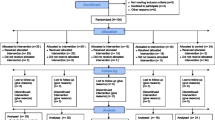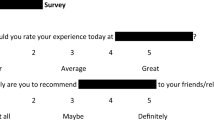Abstract
In the patient-centered practice of musculoskeletal interventional radiology, pre-procedure, intra-procedure, and post-procedure factors impact the patient’s overall experience. Opportunities to improve the patient experience begin before the patient procedure starts, with smooth scheduling of the appointment, a positive office environment, and appropriate communication by the musculoskeletal interventional radiology staff before the procedure, including clear expectations regarding wait times. The initial conversation between the radiologist and the patient, including the informed consent process, is a crucial opportunity for creating rapport with the patient and generating trust in the radiologist. Being able to interpret a patient’s verbal and non-verbal cues during this conversation can reduce anxiety and enhance relaxation. During the procedure, there are interventions which can decrease anxiety and reduce the perception of pain by the patient. These include psychological interventions such as self-induced hypnosis, communication-based interventions such as empathic communication to mold a patient’s interpretation of anxiety and painful stimuli, and the use of ancillary tools such as music or video stimulation. Finally, clear post-procedure expectations regarding post-procedure pain and its management and assurances of access to the musculoskeletal interventional radiology team can facilitate an uncomplicated post-procedure recovery.

Similar content being viewed by others
References
Obele CC, Duszak R Jr, Hawkins CM, Rosenkrantz AB. What patients think about their interventional radiologists: assessment using a leading physician ratings website. J Am Coll Radiol. 2017;14(5):609–14.
Chadderdon AL, Carns DR, Pudalov LR, McKernan LC, Honce JM. Underlying mechanisms of psychological interventions in magnetic resonance imaging and image-guided radiology procedures. Top Magn Reson Imaging. 2020;29(3):157–63.
Makary MS, da Silva A, Kingsbury J, Bozer J, Dowell JD, Nguyen XV. Noninvasive approaches for anxiety reduction during interventional radiology procedures. Top Magn Reson Imaging. 2020;29(4):197–201.
Le TQ, Sanchez Y, Saini S, Sheridan R, Hirsch JA, Prabhakar AM. Improving the interventional radiology patient experience: effect of a phone communication system revision. J Am Coll Radiol. 2017;14(8):1045–8.
Cazzato RL, de Rubeis G, de Marini P, Auloge P, Dalili D, Weiss J, et al. Interventional radiology outpatient clinics (IROC): clinical impact and patient satisfaction. Cardiovasc Intervent Radiol. 2021;44(1):118–26.
Villarreal MC, Rostad BS, Wright R, Applegate KE. Improving procedure start times and decreasing delays in interventional radiology: a department’s quality improvement initiative. Acad Radiol. 2015;22(12):1579–86.
Davies L, Laasch HU, Wilbraham L, Marriott A, England RE, Martin DF. The consent process in interventional radiology: the role of specialist nurses. Clin Radiol. 2004;59(3):246–52.
Doyal L. Informed consent: moral necessity or illusion? Qual Health Care. 2001;10(Suppl 1):i29-33.
Hopper KD, Houts PS, TenHave TR, Matthews YL, Colon E, Haseman DB, et al. The effect of informed consent on the level of anxiety in patients given i.v. contrast material. AJR Am J Roentgenol. 1994;162(3):531–5.
Kerrigan DD, Thevasagayam RS, Woods TO, Mc Welch I, Thomas WE, Shorthouse AJ, et al. Who’s afraid of informed consent? BMJ. 1993;306(6873):298–300.
Forrow L, Kontrimas JC. Language barriers, informed consent, and effective caregiving. J Gen Intern Med. 2017;32(8):855–7.
Schupp CJ, Berbaum K, Berbaum M, Lang EV. Pain and anxiety during interventional radiologic procedures: effect of patients’ state anxiety at baseline and modulation by nonpharmacologic analgesia adjuncts. J Vasc Interv Radiol. 2005;16(12):1585–92.
Sivaganesan A, Chotai S, Parker SL, Asher AL, McGirt MJ, Devin CJ. Predictors of the efficacy of epidural steroid injections for structural lumbar degenerative pathology. Spine J. 2016;16(8):928–34.
Ip HY, Abrishami A, Peng PW, Wong J, Chung F. Predictors of postoperative pain and analgesic consumption: a qualitative systematic review. Anesthesiology. 2009;111(3):657–77.
Lang EV, Benotsch EG, Fick LJ, Lutgendorf S, Berbaum ML, Berbaum KS, et al. Adjunctive non-pharmacological analgesia for invasive medical procedures: a randomised trial. Lancet. 2000;355(9214):1486–90.
Wampold BE. How important are the common factors in psychotherapy? An Update World Psychiatry. 2015;14(3):270–7.
Sven-Olof Trangeberg O, Stomberg MW. Listening to music during regional anesthesia: patients’ experiences and the effect on mood. J Perianesth Nurs. 2013;28(5):291–7.
Soo MS, Jarosz JA, Wren AA, Soo AE, Mowery YM, Johnson KS, et al. Imaging-guided core-needle breast biopsy: impact of meditation and music interventions on patient anxiety, pain, and fatigue. J Am Coll Radiol. 2016;13(5):526–34.
Cho SW, Choi HJ. Effect of music on reducing anxiety for patients undergoing transrectal ultrasound-guided prostate biopsies: randomized prospective trial. Urol J. 2016;13(2):2612–4.
Kulkarni S, Johnson PC, Kettles S, Kasthuri RS. Music during interventional radiological procedures, effect on sedation, pain and anxiety: a randomised controlled trial. Br J Radiol. 2012;85(1016):1059–63.
Mandle CL, Domar AD, Harrington DP, Leserman J, Bozadjian EM, Friedman R, et al. Relaxation response in femoral angiography. Radiology. 1990;174(3 Pt 1):737–9.
Koch ME, Kain ZN, Ayoub C, Rosenbaum SH. The sedative and analgesic sparing effect of music. Anesthesiology. 1998;89(2):300–6.
Hayes N, Garrett D. Value of music. Nurs Older. People. 2016;28(10):25.
Buffum MD, Sasso C, Sands LP, Lanier E, Yellen M, Hayes A. A music intervention to reduce anxiety before vascular angiography procedures. J Vasc Nurs. 2006;24(3):68–73.
Li W, Bryan RG 2nd, Kheterpal A, Simeone FJ, Chang CY, Torriani M, et al. The effect of music on pain and subjective experience in image-guided musculoskeletal corticosteroid injections: a randomized controlled trial. Skeletal Radiol. 2020;49(3):435–41.
Fang AS, Movva L, Ahmed S, Waldman D, Xue J. Clinical efficacy, safety, and feasibility of using video glasses during interventional radiologic procedures: a randomized trial. J Vasc Interv Radiol. 2016;27(2):260–7.
Al-Assam H, Azzopardi C, McGarry S, Botchu R. Vasovagal reactions in ultrasound guided musculoskeletal injections: a study of 2,462 procedures. J Clin Orthop Trauma. 2022;24:101706.
Botwin KP, Gruber RD, Bouchlas CG, Torres-Ramos FM, Freeman TL, Slaten WK. Complications of fluoroscopically guided transforaminal lumbar epidural injections. Arch Phys Med Rehabil. 2000;81(8):1045–50.
Botwin KP, Castellanos R, Rao S, Hanna AF, Torres-Ramos FM, Gruber RD, et al. Complications of fluoroscopically guided interlaminar cervical epidural injections. Arch Phys Med Rehabil. 2003;84(5):627–33.
Kennedy DJ, Schneider B, Casey E, Rittenberg J, Conrad B, Smuck M, et al. Vasovagal rates in flouroscopically guided interventional procedures: a study of over 8,000 injections. Pain Med. 2013;14(12):1854–9.
Stauber B, Ma L, Nazari R. Cardiopulmonary arrest following cervical epidural injection. Pain Physician. 2012;15(2):147–52.
Santini M, Ammirati F, Colivicchi F, Gentilucci G, Guido V. The effect of atropine in vasovagal syncope induced by head-up tilt testing. Eur Heart J. 1999;20(23):1745–51.
Vazquez R, Hamilton C. Abstract No. 447 Quality improvement: creation and sustainability of an enhanced recovery after procedure initiative for hepatic microwave ablation. SIR 2021 Annual Scientific Meeting Program 20 March – 26 March 2021. Journal of Vascular and Interventional Radiology. 2021;32(5):S109.
Palmer WE. Spinal Injections for Pain Management. Radiology. 2016;281(3):669–88.
Author information
Authors and Affiliations
Contributions
Both authors (JD and AJH) contributed to (1) conception and design, or acquisition, or analysis and interpretation of data (interpreted as review of literature), (2) drafting the article or revising it critically for important intellectual content, (3) final approval of the version to be published, and (4) agree to be accountable for all aspects of the work if questions arise related to its accuracy or integrity.
Corresponding author
Ethics declarations
Conflict of interest
The authors declare no competing interests.
Additional information
Publisher's note
Springer Nature remains neutral with regard to jurisdictional claims in published maps and institutional affiliations.
Rights and permissions
Springer Nature or its licensor holds exclusive rights to this article under a publishing agreement with the author(s) or other rightsholder(s); author self-archiving of the accepted manuscript version of this article is solely governed by the terms of such publishing agreement and applicable law.
About this article
Cite this article
Delgado, J., Huang, A.J. Improving the patient experience during musculoskeletal interventional procedures. Skeletal Radiol 52, 889–895 (2023). https://doi.org/10.1007/s00256-022-04154-x
Received:
Revised:
Accepted:
Published:
Issue Date:
DOI: https://doi.org/10.1007/s00256-022-04154-x




